You Can Help.
 While the overall watershed health grade is an underwhelming C, there are many opportunities for individual citizens, landowners, farmers, business owners, industry leaders, utility managers, community leaders, and public officials to help raise that grade.
While the overall watershed health grade is an underwhelming C, there are many opportunities for individual citizens, landowners, farmers, business owners, industry leaders, utility managers, community leaders, and public officials to help raise that grade.
Here are some places to start:
- Make small, but impactful choices at home or work
- Help sample water to find pollution hot spots
- Learn more about the White River
- Explore changing live river conditions
- Discover and share things to do on, along, or around the river
- Participate in the Indiana Water Summit & it’s Working Group
- Register to Vote
Our report card has some concerning D and F grades that warrant our collective, prioritized attention. It is important to focus on strategies to improve these bad grades in the near term, especially since they are indicators that impact human health, create risks, and limit our potential and sustainability as a region.
The indicators that demand them most immediate action include:
![]() Wetland Change (historic and ongoing wetland loss)
Wetland Change (historic and ongoing wetland loss)
![]() Bacteria in our Water
Bacteria in our Water
![]() Environmental Burden
Environmental Burden
Raising our grades requires an informed and participating public to help drive change. For this reason, increasing voter participation remains an important strategy in protecting our watershed.
Protect Critical Natural Resource Assets
 The greatest opportunity to affect change across the watershed lies in the protection of critical natural assets. These assets, also known as natural green infrastructure, include wetlands, forests, and floodplains. In the landscape, these assets function to treat water pollution, recharge groundwater supplies, protect communities from flooding, clean air, and lessen climate change impacts. State and local regulations, incentive programs that facilitate conservation, and investments in the restoration of these ecosystems are the most important and impactful solutions for both watershed and public health.
The greatest opportunity to affect change across the watershed lies in the protection of critical natural assets. These assets, also known as natural green infrastructure, include wetlands, forests, and floodplains. In the landscape, these assets function to treat water pollution, recharge groundwater supplies, protect communities from flooding, clean air, and lessen climate change impacts. State and local regulations, incentive programs that facilitate conservation, and investments in the restoration of these ecosystems are the most important and impactful solutions for both watershed and public health.
Reduce and Prevent 💩 Sources and Runoff
 Human and animal waste pollution is severely limiting recreation and economic development opportunities and threatening public health. While large-scale efforts are ongoing to lessen combined sewer overflows, many other more diffuse sources of waste need attention. Solutions can be implemented by ordinance or incentive. They include the use of natural buffers along streams and stormwater ponds to help trap and treat polluted runoff from farms and urban landscapes, fencing livestock out of streams, deploying manure management systems, investing in septic system education, maintenance, inspections, enforcement, and increasing access to sewer connections.
Human and animal waste pollution is severely limiting recreation and economic development opportunities and threatening public health. While large-scale efforts are ongoing to lessen combined sewer overflows, many other more diffuse sources of waste need attention. Solutions can be implemented by ordinance or incentive. They include the use of natural buffers along streams and stormwater ponds to help trap and treat polluted runoff from farms and urban landscapes, fencing livestock out of streams, deploying manure management systems, investing in septic system education, maintenance, inspections, enforcement, and increasing access to sewer connections.
Invest In Alternative Energy, Transportation, & Emission Strategies
 Community health reflects watershed health. Poor environmental burden grades represent the impacts that land use, environmental policy, and pollution prevention strategies have on people. Reducing this burden requires our efforts to address lead exposure, remediate brownfields, and lessen air pollution. Solutions include investments in renewable energy sources, public transportation and bike/pedestrian infrastructure, and emission reduction strategies in collaboration with industry partners.
Community health reflects watershed health. Poor environmental burden grades represent the impacts that land use, environmental policy, and pollution prevention strategies have on people. Reducing this burden requires our efforts to address lead exposure, remediate brownfields, and lessen air pollution. Solutions include investments in renewable energy sources, public transportation and bike/pedestrian infrastructure, and emission reduction strategies in collaboration with industry partners.
Shift Development Practices to be Sustainable
 Some additional key solutions will result in unique localized benefits and better subregion grades. Specific areas of the watershed could be greatly improved by small shifts in development practices that promote density and reduce the amount of paved surfaces across the landscape. Likewise, neighborhood-level investment in affordable housing is also essential to local viability and sustainability. Lastly, targeted increases in parks, trails, and tree canopy cover can provide measurable improvements to community health.
Some additional key solutions will result in unique localized benefits and better subregion grades. Specific areas of the watershed could be greatly improved by small shifts in development practices that promote density and reduce the amount of paved surfaces across the landscape. Likewise, neighborhood-level investment in affordable housing is also essential to local viability and sustainability. Lastly, targeted increases in parks, trails, and tree canopy cover can provide measurable improvements to community health.
There Are Resources Available.
 NRCS Farm Bill Programs & Assistance
NRCS Farm Bill Programs & Assistance
Indiana Finance Authority Grant & Loan Programs
IDEM 319 Watershed Management Program
IDNR Lake and River Enhancement Program
IASWCD Clean Water Indiana Program
NFWF Five Star and Urban Waters Restoration Program
IDNR Next Level Trails Program
More coming soon!
